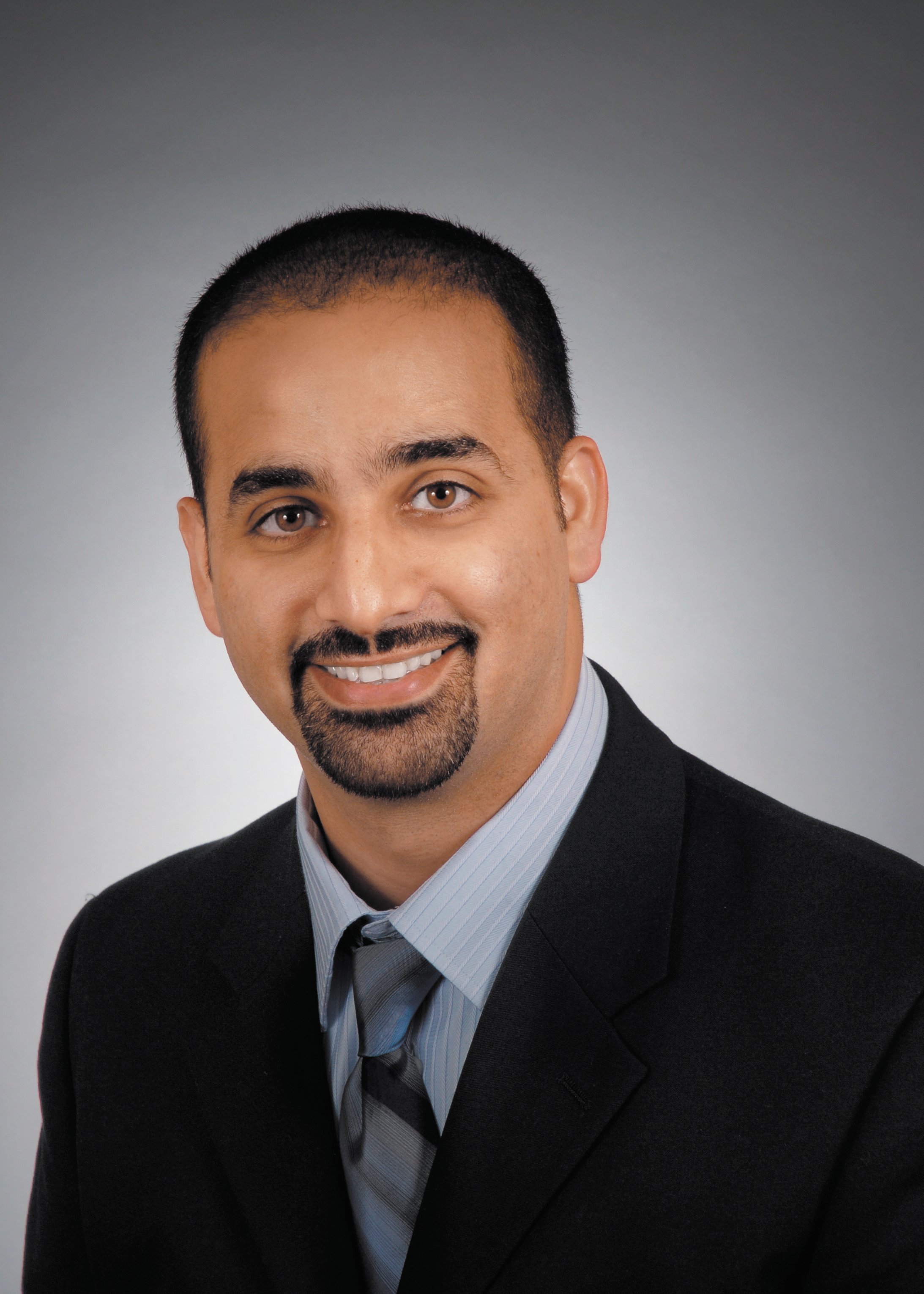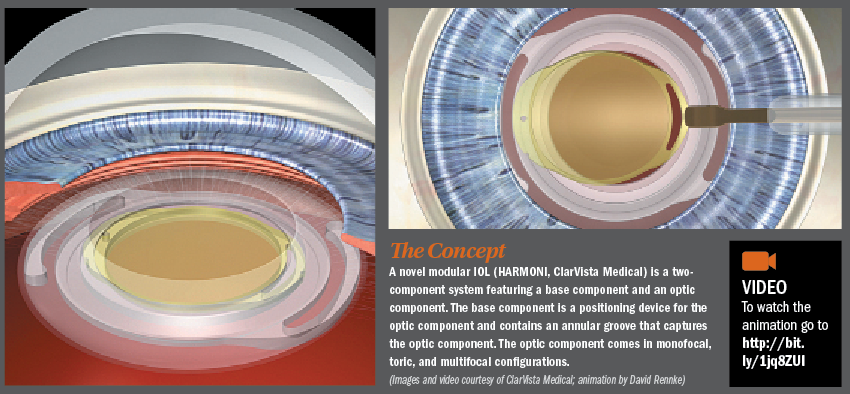Article
Modular IOL system begins clinical evaluation
An investigational modular IOL was designed to improve surgeons’ ability to select the right optic the first time, enable safe and easy postoperative enhancement when required, and minimize posterior capsule opacification. A multicenter clinical trial evaluating the IOL was launched in October.
Take Home
An investigational modular IOL was designed to improve surgeons’ ability to select the right optic the first time, enable safe and easy postoperative enhancement when required, and minimize posterior capsule opacification. A multicenter clinical trial evaluating the IOL was launched in October.

Dr. Kahook
By Cheryl Guttman Krader; Reviewed by Paul McLean, Harvey Uy, MD, Cesar Espiritu, MD, and Malik Kahook, MD
Despite all of the recent advances that have occurred in cataract surgery, several important challenges remain.
Overall, refractive outcomes are less than satisfactory. Not only do contemporary studies show that as many as 30% to 50% of patients are left with 0.5 D or more of residual refractive error, but the postoperative techniques for correcting these errors-ie., cornea-based procedures, a piggybacked IOL, and IOL exchange-are far from ideal.
Moreover, the difficulty of IOL exchange creates challenges in a myriad of other situations where it might be indicated, such as adjusting for changing refraction as a child matures after cataract surgery, satisfying patients’ needs to upgrade to a premium IOL, or managing those who are unhappy after implantation of a multifocal IOL. In addition, prevention of posterior capsule opacification (PCO) continues to be an unmet need.
VIDEO
Harmoni Modular IOL
The Harmoni Modular IOL, an investigational platform invented by Malik Kahook, MD, is a novel concept designed to address all of these issues.
The device is being developed by ClarVista Medical, and after undergoing extensive benchtop and preclinical testing, it entered clinical evaluation in a multicenter trial launched in October, 2013.
The Harmoni Modular IOL is a two-component system that is expected to improve refractive outcomes after the primary procedure by improving surgeons’ ability to select the right optic the first time. In addition, it is designed to enable safe and easy postoperative enhancement when required, and to reduce the overall cost of care by minimizing the development of PCO.
“We have been working on the development of this IOL technology for 2 years and are excited about it as a platform that will bring important new options for improving outcomes in cataract surgery,” said Paul McLean, President and chief executive officer, ClarVista Medical, Aliso Viejo, CA.

Dr. Espiritu
“The modular design of the Harmoni IOL will allow the surgeon to tailor refractive outcomes intraoperatively, combined with intraoperative aberrometry, as well as postoperatively when needed, leading to enhanced patient outcomes,” said Dr. Kahook, The Slater Family Endowed Chair in Ophthalmology and professor of ophthalmology, University of Colorado, Denver. “The modular design will also allow us to introduce new technology to cataract surgery that will decrease PCO and improve effective lens position in the capsular bag. Combined, these benefits should make the Harmoni IOL an attractive choice for both surgeon and patient.”
Harvey Uy, MD, implanted the first Harmoni Modular IOL in the clinical trial. He is a consultant at the Pacific Eye and Laser Institute, St. Luke’s Medical Center, and clinical associate professor of ophthalmology, University of the Philippines, Manila.
“I believe this technology will greatly elevate the accuracy and precision of refractive cataract surgery,” Dr. Uy said. “The Harmoni Modular IOL provides cataract surgeons a means for adjusting the optic to achieve the best outcome by minimizing refractive error, and that is good news for all cataract surgeons.”

Harmoni design
The Harmoni Modular IOL is comprised of a universal base component and an exchangeable aspheric optic component. Both pieces are constructed of a well-characterized, glistening-free hydrophobic acrylic material. Each of the two components can be inserted through a 2.2-mm incision using a standard injector system.
Tthe two-component design enables use of a slightly larger ‘rhexis that still overlaps with the base component, which should limit potential for glare from the anterior capsule edge.
Introduced first, the base component serves as a positioning device for the optic. Its proprietary design shows promise for delivering increased predictability of effective lens position (ELP) and for inhibiting PCO. The optic component nests within an annular groove in the base and will be offered in monofocal, multifocal, and toric versions.
“Our product allows residual refractive error to be addressed at its source, which is the IOL optic, and in an easy and safe procedure that avoids traumatic manipulations to free the haptics from the capsular bag,” McLean said. “We feel it has an important advantage for improving refractive outcomes in all cataract patients and especially for offering new opportunities to remedy the myriad of situations that can be encountered postoperatively in premium IOL patients.
“In addition to addressing residual refractive error and allowing for easy IOL exchange in patients wanting to change from a monofocal to a multifocal optic and vice versa, the modular IOL design allows surgeons to manage a misaligned toric IOL without having to manipulate the capsular bag,” he continued.

Dr. Uy
Adapting the technology
The Harmoni Modular IOL is also expected to work well with intraoperative wavefront technologies.
Although real-time refractive measurements obtained with the patient on the operating table are helping surgeons to optimize IOL power selection, the outcome can still be disappointing because postoperative lens position remains uncertain.
“By enabling a more predictable ELP, the Harmoni Modular IOL should allow for better refractive results in more patients,”McLean said.
Dr. Uy noted that because the exact position of the optic will be known, the refractive outcomes after Harmoni optic exchange should also be better than after conventional IOL exchange.
“Knowing the ELP will be of immense help in selecting the correct IOL power to eliminate residual refractive error,” he explained.
Dr. Uy performed the first procedure in the Harmoni Modular IOL clinical trial in October. By early December, he had implanted 18 eyes with the investigational IOL.
Dr. Uy noted that there is no need to change cataract removal technique when using the novel IOL. The procedure can be performed just as easily using conventional or laser-assisted surgical approaches, and the need to implant two pieces instead of one increases the surgical time by just 1 minute.
“There is a short learning curve in joining the two components,” he said. “However, this step is very easy if care is taken to join the leading optic edge to the groove in the base component during the injection process. We have coined this step the ‘Uy maneuver’.”
More features
Cesar Espiritu, MD, the other investigator in the multicenter study, noted that the easy to learn implantation technique is another favorable feature of the Harmoni Modular IOL.
“There are some basic do’s and don’ts to follow that enable success, and after just two cases, I was comfortable and confident with the technique,” said Dr. Espiritu, chief medical officer, The American Eye Center, Manila, The Philippines, and chairman, department of ophthalmology, Manila Doctors Hospital, Manila.
Dr. Espiritu added that he believes future improvements in the device will further increase the ease of implantation as well as in-the-bag stability of the modular IOL system.
The findings from postoperative follow-up in the five eyes Dr. Espiritu had implanted so far showed excellent results, he said. Patients achieved the expected corneal clarity on postoperative day 1, had no significant anterior chamber reaction or remarkable IOP elevations, and most importantly, UCVAs were very good.
Commenting on an optic exchange case he performed, Dr. Uy said the procedure was much easier than replacing a conventional IOL.
He observed that while capsular bag fibrosis is what makes haptic removal difficult when exchanging a conventional IOL, it does not impact the HARMONI system.
“The first in man trial has gone extremely well to date with over 50% enrollment completed,” Dr. Kahook said. “We are anxious to start analyzing the data more thoroughly. However, an early review shows excellent clinical outcomes and no more than a minute added to surgical time compared to market leading IOL implantation.”
Paul McLean
E: pmclean@clarvistamedical.com
Harvey Uy, MD
Dr. Uy is a paid principal investigator for Clarvista and member of the advisory board.
Cesar Espiritu, MD
Dr. Espiritu is a study and clinical trial consultant for ClarVista.
Malik Kahook, MD
E: malik.kahook@ucdenver.edu
Dr. Kahook is a consultant to and has intellectual property interests with ClarVista.
Subscribe to Ophthalmology Times to receive the latest clinical news and updates for ophthalmologists.
Newsletter
Don’t miss out—get Ophthalmology Times updates on the latest clinical advancements and expert interviews, straight to your inbox.





